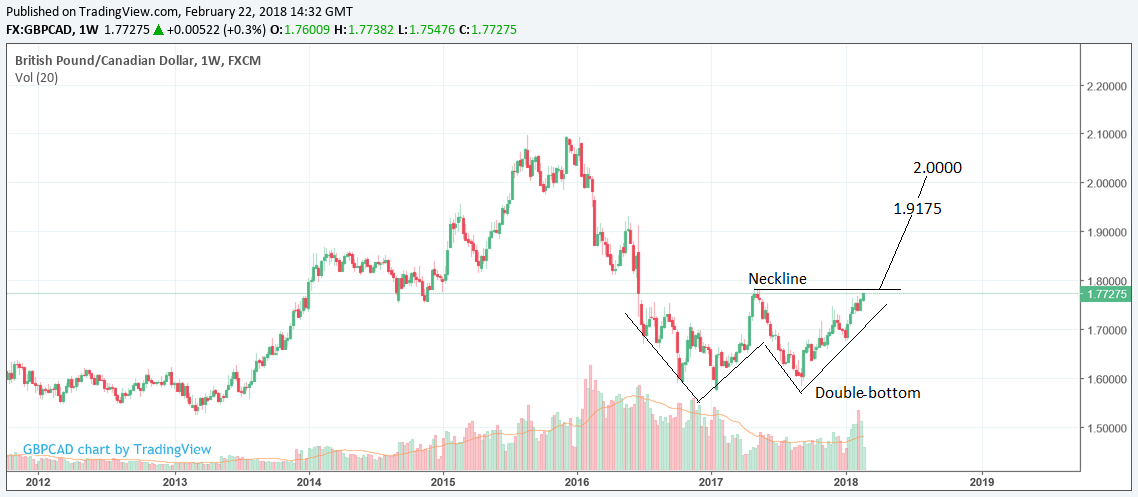Canadian Retail Slump Drives USD/CAD, GBP/CAD Through Key Levels: Where Next?
- Written by: James Skinner

© thanasak, Adobe Stock
Traders were expecting the Bank of Canada to raise interest rates by 25 basis points again before July but Thursday’s data has probably dented this expectation, with implications for the Loonie.
The Canadian Dollar slumped against the US greenback, British Pound and Euro Thursday as markets responded to a dire final instalment of retail sales data for 2017.
Headline Canadian retail sales fell by -0.8% in December, according to the Statistics Canada report, when they had been expected to sit unchanged for the month. Core retail sales fell even further, dropping by 1.8% when the market consensus had been for a small rise of 0.1% to round off the year.
“Lower sales at general merchandise; health and personal care; and electronics and appliance stores more than offset gains at motor vehicle and parts dealers and food and beverage stores,” Statistics Canada says.
The core measure removes automobile sales from the numbers as they are high value items that can distort the underlying trend in consumer spending. Markets tend to focus on this measure more because it provides a better reflection of Canadian household spending.
“December isn't what it used to be for retail sales, and that showed up in the 2017 figures. A change in seasonality towards an early holiday shopping pattern with the advent of Black Friday sales and the like explain part of the weakness, but with a 0.8% drop on the headline, retail sales over the past two months are down by half a percent,” says Nick Exarhos, an economist at CIBC Capital Markets.
The USD/CAD rate was quoted 0.29% higher at 1.2734 in response to the report, after reversing an earlier loss, while the Pound-to-Canadian-Dollar rate was marked 0.26% higher at 1.7706 after reversing an earlier 0.25% loss. The EUR/CAD rate was up 0.44% at 1.5660.
Core Canadian retail sales surged higher back in November, rising 1.6%, twice the rate forecast by economists.
Statistics Canada said at the time the surge was the result of higher sales at electronics and appliance stores and, since then, has noted a sharp increase in imports of telecoms equipment into Canada toward the end of the year.
The bulk of market observers put this surge down to the November release of the latest Apple iPhone, which might have made the December slowdown easier to swallow at the Bank of Canada, although all of these gains now look to have been reversed.
Retail sales and consumer spending matter for markets because they are an important influence on domestic inflation and an ideal bellwether of just how well households are coping with the three interest rate rises announced by the Bank of Canada in the last eight months.
“All told, a reason to keep the Canadian Dollar trading weak, with work still to be done in pricing out the Spring tightening bias expected from the BoC,” says Exarhos.
Pricing in interest rate derivatives markets, which enable traders to protect themselves against changes in interest rates, implies that traders are expecting the Bank of Canada to raise interest rates again by 25 basis points before July.
Thursday’s data may now have dented this expectation, with implications for the Canadian Dollar going forward.
“Taken in tandem with what is deemed to be a still too optimistic expectation for BoC rate hikes before July, we are comfortable in holding a defensive stance on CAD especially as the USD has regained a minor tactical footing recently,” says Fred Demmers, chief Canada macro strategist at TD Securities, in a note ahead of the retail data.
“1.2690 will be the key litmus test on the topside as this was the post-LFS high, and failure to hold will open considerable upside potential ahead of CPI on Friday.”
The USD/CAD rate shot through the 1.2690 level after Statistics Canada announced December’s figures and, according to TD’s Demmers, may now advance on to new highs ahead of Friday’s Canadian inflation report and next week’s December GDP report.
GBP/CAD, USD/CAD Technicals
The USD/CAD rate the Pound-to-Canadian-Dollar rate both broke above key technical levels on Thursday, in the wake of Statistics Canada's report.
"GBPCAD closed above resistance at 1.7660 yesterday," says Eric Theoret, an FX strategist at Scotiabank. "Trend strength indicators are bullish across short, medium and longer run directional movement index studies, suggesting to us that this move up has legs."
"We reiterate that upside risks extend to the mid 1.85s over the next 2-3 months on the interpretation of price action forming a bull flag through early 2018."
A break above the important May 2017 highs at 1.7857 would also be a very bullish sign, according to Pound Sterling Live technical analyst Joaquin Montfort, as the level could be the neckline of a bottoming pattern called a double-bottom.
"Double-bottoms are 'W' shapped patterns that form at market lows and signal a reversal of the trend from down to up."

Above: Pound-to-Canadian-Dollar rate chart.
"A break above the neckline at 1.7857 would confirm the pattern is valid and usher in a much more bullish phase for GBP/CAD. The usual method for forecasting the likely upside from such a pattern is to take its height and extrapolate it higher. Such a calculation would see upside to a target at as high as 2.00 (double parity)."
"A more conservative forecast would stipulate upside of a 0.618 ratio of the height, which results in a more conservative target at 1.9175. The 0.618% is known as the golden ratio and is an ancient mathematical constant found to be useful in determining proportions in natural phenomenon, as well as financial markets."
Advertisement
Get up to 5% more foreign exchange by using a specialist provider to get closer to the real market rate and avoid the gaping spreads charged by your bank when providing currency. Learn more here.




